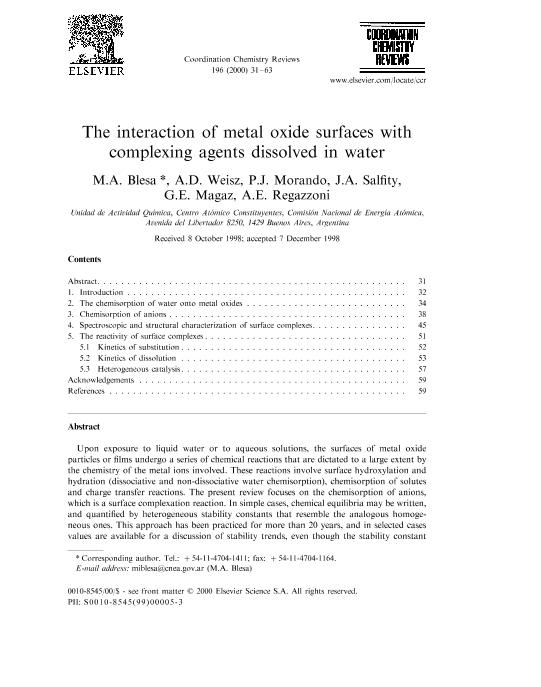Artículo
The interaction of metal oxide surfaces with complexing agents dissolved in water
Blesa, Miguel Angel ; Weisz, Ariel D.; Morando, Pedro Juan
; Weisz, Ariel D.; Morando, Pedro Juan ; Salfity, José Adrián
; Salfity, José Adrián ; Magaz, María del Carmen
; Magaz, María del Carmen ; Regazzoni, Alberto Ernesto
; Regazzoni, Alberto Ernesto
 ; Weisz, Ariel D.; Morando, Pedro Juan
; Weisz, Ariel D.; Morando, Pedro Juan ; Salfity, José Adrián
; Salfity, José Adrián ; Magaz, María del Carmen
; Magaz, María del Carmen ; Regazzoni, Alberto Ernesto
; Regazzoni, Alberto Ernesto
Fecha de publicación:
01/2000
Editorial:
Elsevier Science Sa
Revista:
Coordination Chemistry Reviews
ISSN:
0010-8545
Idioma:
Inglés
Tipo de recurso:
Artículo publicado
Clasificación temática:
Resumen
Upon exposure to liquid water or to aqueous solutions, the surfaces of metal oxide particles or films undergo a series of chemical reactions that are dictated to a large extent by the chemistry of the metal ions involved. These reactions involve surface hydroxylation and hydration (dissociative and non-dissociative water chemisorption), chemisorption of solutes and charge transfer reactions. The present review focuses on the chemisorption of anions, which is a surface complexation reaction. In simple cases, chemical equilibria may be written, and quantified by heterogeneous stability constants that resemble the analogous homogeneous ones. This approach has been practiced for more than 20 years, and in selected cases values are available for a discussion of stability trends, even though the stability constant values are sensitive to double-layer modeling and to the history of the metal oxide used. Most of the stability constants have been derived in conventional ways from measurements of the corresponding adsorption isotherms, a procedure that does not provide structural information. Modeling of the shape and pH dependence of adsorption isotherms has been however used to propose various modes of adsorption, in order to derive, for instance, the speciation of surface complexes as a function of ligand concentration and pH. Presently, structural techniques are available to probe directly into the structure of the surface ensembles; the use of UV-vis, IR, magnetic and surface spectroscopies, together with EXAFS and SEXAFS has provided credence to the surface complexation approach, as discussed in the present review for selected cases. In particular, attenuated total refection FTIR has proved to be a powerful tool to derive the surface speciation in selected cases. The reactivity patterns of the surface complexes is being currently explored. The catalysis of ester hydrolysis, the rates and mechanisms of oxide dissolution, heterogeneous charge transfer reactions and the photocatalytic reactions of oxidation of organic compounds can all, in certain cases, be described as reactions of specific surface complexes; some relevant examples are discussed.
Archivos asociados
Licencia
Identificadores
Colecciones
Articulos(SEDE CENTRAL)
Articulos de SEDE CENTRAL
Articulos de SEDE CENTRAL
Citación
Blesa, Miguel Angel; Weisz, Ariel D.; Morando, Pedro Juan; Salfity, José Adrián; Magaz, María del Carmen; et al.; The interaction of metal oxide surfaces with complexing agents dissolved in water; Elsevier Science Sa; Coordination Chemistry Reviews; 196; 1; 1-2000; 31-63
Compartir
Altmétricas



